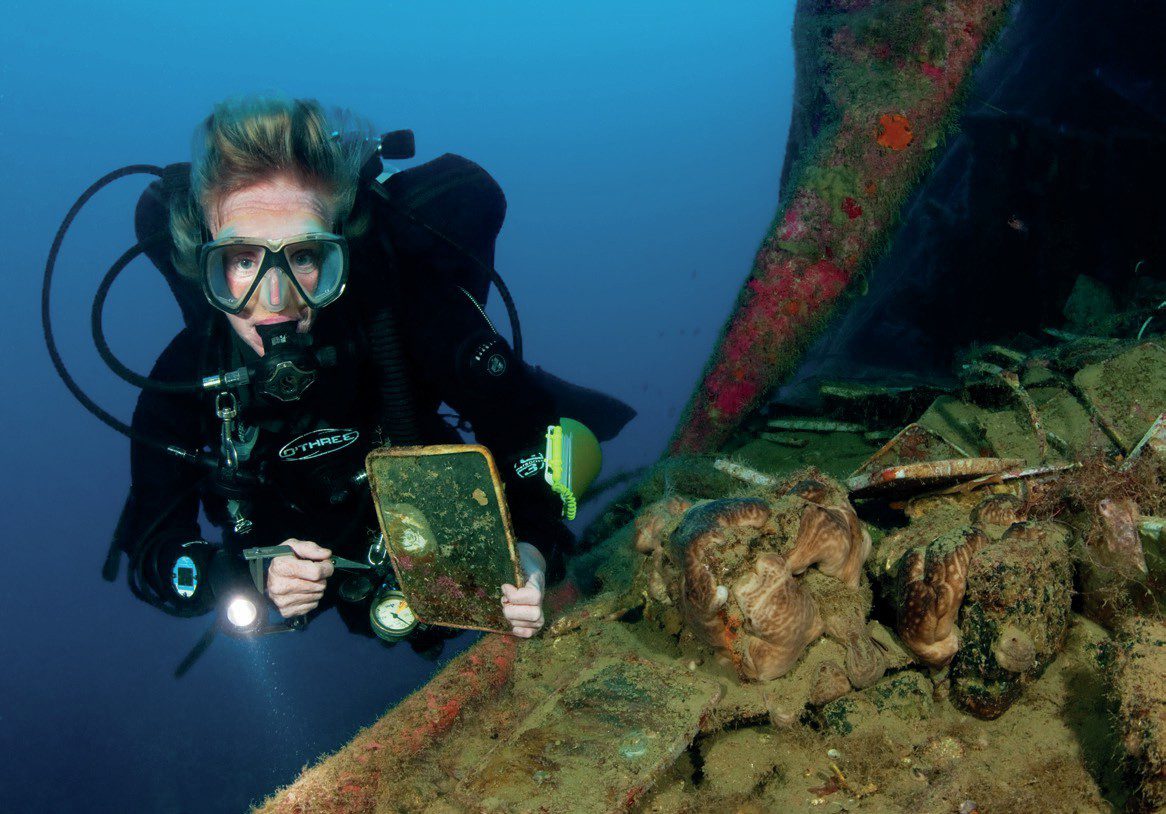The Zenobia is the jewel in the crown of the Cyprus wreck-diving scene, and while the massive vessel can be dived by recreational divers, Stuart Philpott reckons to make the most of exploring the wreck, you should go the technical route.
Photographs by Stuart Philpott
History and Characteristics of the MS Zenobia
At 2am on 7 June 1980, MS Zenobia sank beneath the waves less than 2km off Larnaca in Cyprus. To this day her demise is steeped in controversy and intrigue, with tales of insurance scams and sabotage. The 172 metre long by 28 metre beam, 10,000 ton, RO-RO ferry now lies on her port side at a max depth of 42m, fully laden with 108 articulated trucks and other machinery.
No salvage work has ever been carried out. Much of her £200 million cargo still lies undisturbed within her holds. Each year, thousands of visiting divers pay homage, but very few venture deep inside. This is far beyond the realms of recreational scuba. Proper tech training is required, otherwise the wreck could be fatal.
Navigating the Decks of the Zenobia
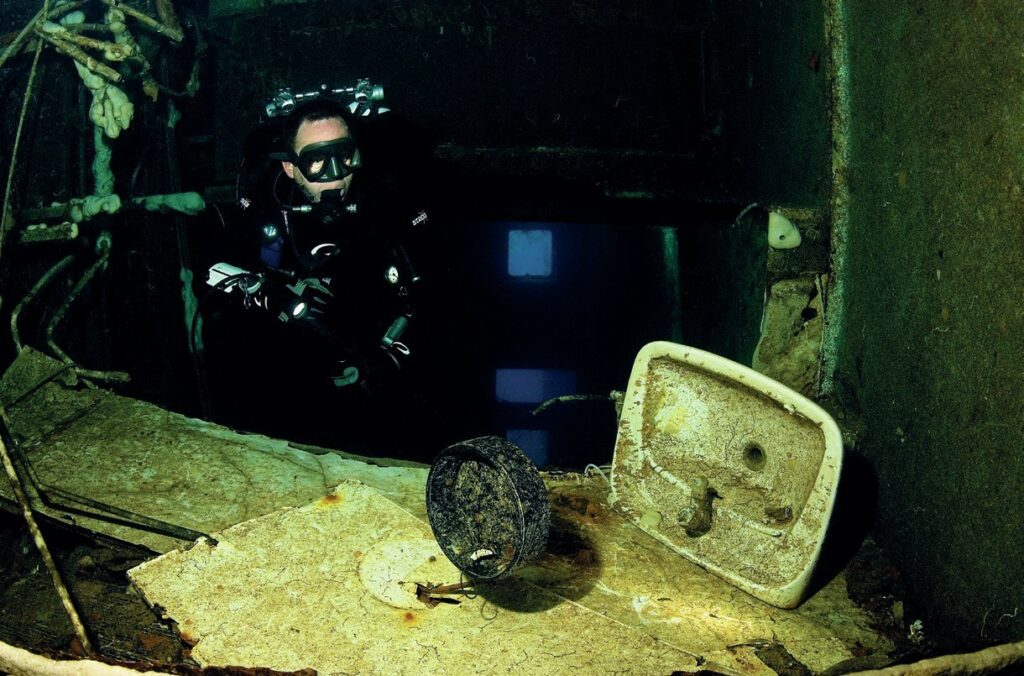
The Zen offers three cargo decks for penetration\ exploration. The upper deck level is the easiest and the lower deck more complex. Just to make life even more interesting, the wreck lies on her port side, which can be very disorientating. My guide, TDI Tech Instructor Chris Demetriou, had logged 1,000s of penetration dives and mapped out ten core routes passing through the Zen. Chris said: “The wreck starts at around 16m to 18m, but the really good stuff lies at 24m’.
Dive Training and Preparation
This is the perfect tech diver training ground for nitrox right through to trimix and rebreather. Chris said: “We can do most skill sets on the Zen unless there is a specific depth requirement. We do a lot of tech training by the lifeboats and inside the Captain’s cabin.”
Technical Dive Packages and Logistics
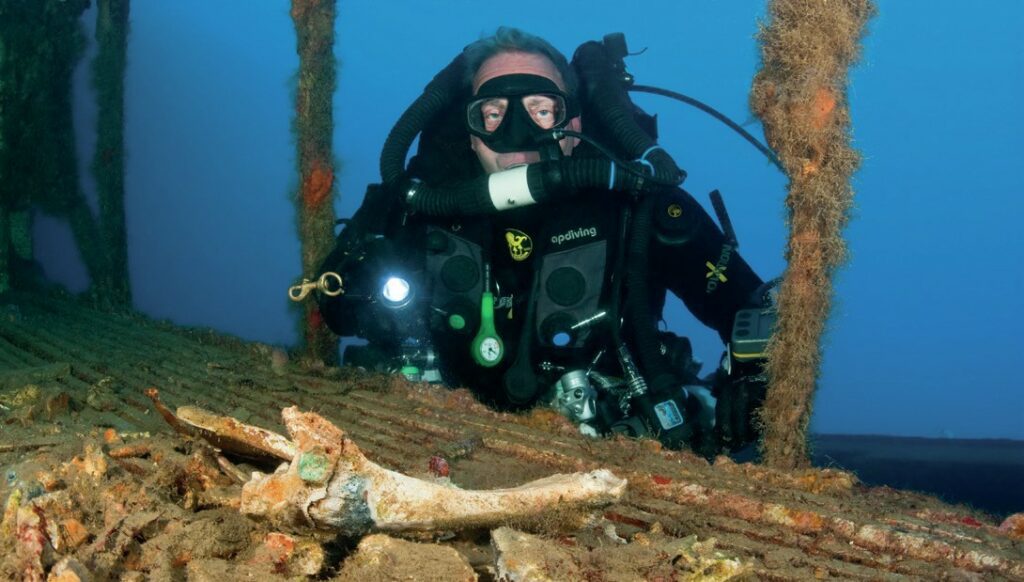
There are a number of dive centres offering special Zenobia tech wreck weeks, which include ten guided dives increasing in penetration on each dive. But this depends on individual requirements, qualifications and experience levels. Divers can just spend the whole ten dives looking around the outside. There is no pressure to delve into the deeper, more-complex areas. Penetration dives are not for everyone. Boat journey times from Larnaca fishing harbour to the wreck site are literally a few minutes. There are permanent marker buoys attached to the stern, amidships and bow. Trapeze set-ups are also in place to make any deco-stops more comfortable.
The Zenobia's Long History of Exploration
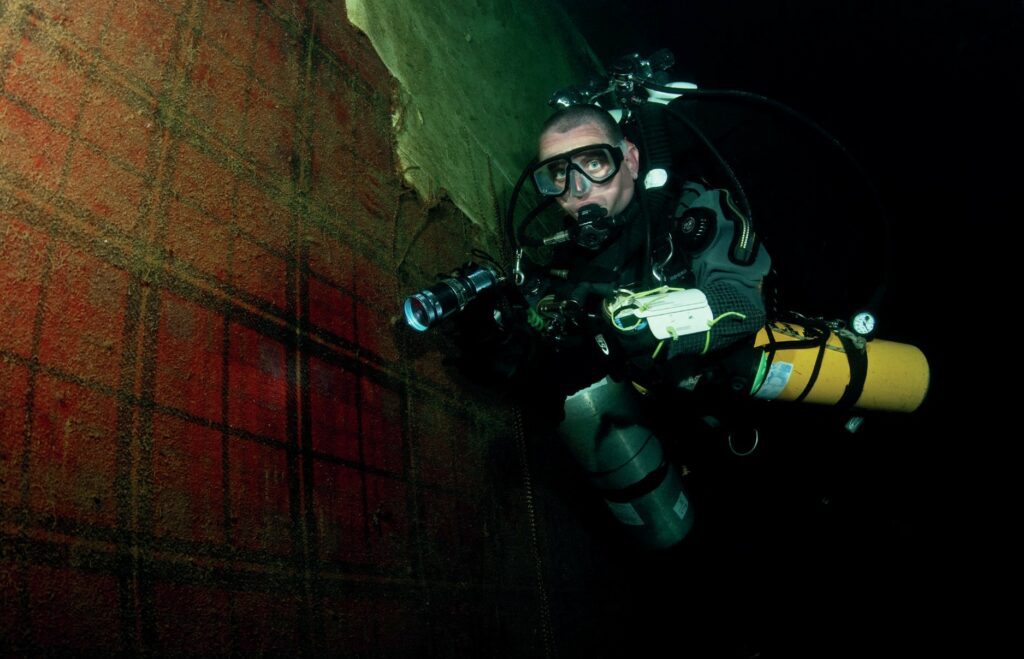
Technical divers have been raiding the Zen for decades. One by one, each compartment has been breached. The final stronghold was overcome back in July 2008 when, after years of planning, a small team of dedicated divers broke into the auxiliary engine room and entered the control room. I was fortunate enough to be the seventh diver to venture inside. Chris explained ‘going inside the auxiliary engine room is a complete leap of faith. If the door closes, you’re dead’. Rust flakes disturbed by exhaled bubbles and wayward fin kicks can quickly reduce visibility to zero. One of our support team waited at the doorway shining a torch for us to follow in an emergency.
Chris said ‘you have to treat the Zen with respect. If you can’t find the way out, it’s see you later time’. The control room is probably one of the most-difficult penetration dives, the Zen has to offer. The access route is via a doorway on the middle car deck. This leads through to the electrician’s workshop, engineering workshop and electrical store. At the end of the corridor is a bulkhead door, which opens up into the auxiliary engine room and then the control room. There is no natural light, or direct access to the surface. It’s just confined spaces and pitch black.
A Glimpse into the Inner Sections of the Zenobia
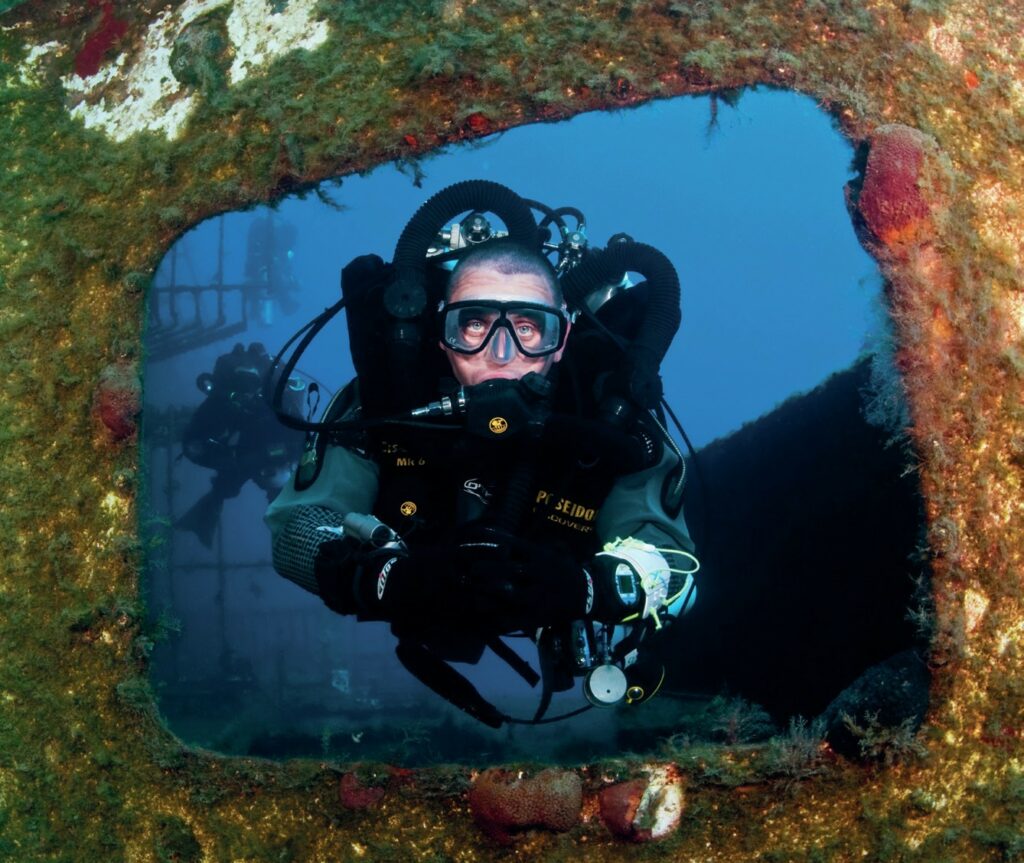
My first warm up dive turned out to be an ‘easy’ penetration dive. Chris guided me through the accommodation block and upper cargo deck. We passed through the bridge, restaurant, restrooms and laundry room. There were plenty of ‘ways out’ with easy access to blue water. Some of the internal partitioning walls had collapsed, but this didn’t cause too much of a hindrance. The tartan patterned restaurant carpet was still in surprisingly good condition. The only ‘cramped’ area was inside the laundry room. Chris said ‘I’ve taken Instructors inside the Zen and after a while it’s quite obvious they’re not happy’. The upper cargo deck also has the P.I.E. truck, truck 33 and another HGV carrying some kind of generator equipment. I could still read all the switches and dials on the control panels. Most of the trucks still have glass headlights and tyres, but trophy hunters have removed some of the steering wheels and radiator badges from the more-accessible trucks. Chris said ‘you shouldn’t take anything off the wreck. When it’s attached it means something. The lorry badges, steering wheels, etc, lose their identity when they are detached and what do you do with it? It just ends up as a piece of scrap metal in somebody’s garden’.
Most tech divers venture no further than the middle cargo deck. There are a total of eight entrances and exits, three of which are direct routes out. The most popular exit is through the pilot door. Chris said ‘Some divers think they can dive anywhere but it all depends on their experience’. Chris guided me through narrow corridors and stairwells that turned out to be surprisingly difficult to negotiate underwater. Even my low-profile twin set kept clanging against metal. Features included a forklift truck lying on its side, Bomag road crushers, container loads of sweets and children’s toys. A tarpaulin cover had been ripped apart revealing hundreds of ‘as new’ looking sleeping bags. One had been unrolled and looked very comfy.
Venturing Deeper into the Wreck
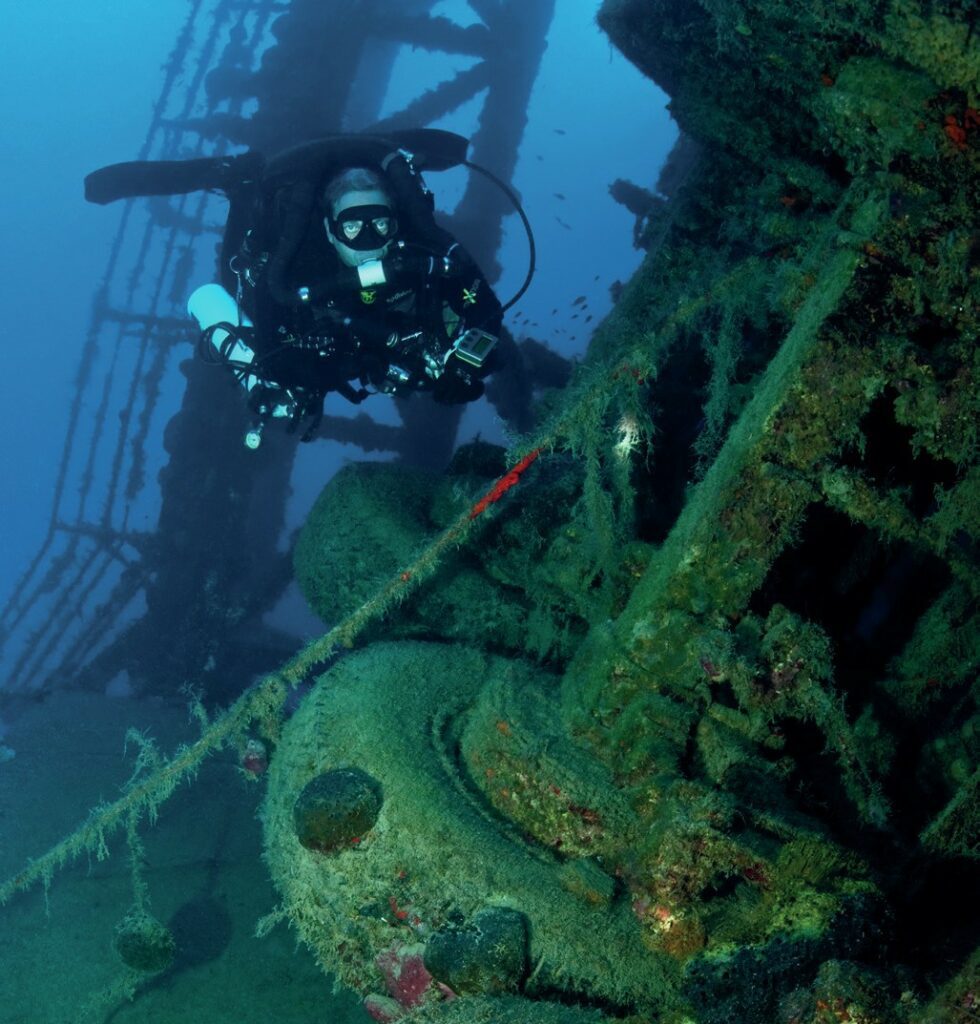
Only a small minority of tech divers venture deeper inside to explore the lower cargo deck, the engine room and the control room. Here the depth drops to a maximum of 42m and the water temperature is much cooler. Chris always wears his drysuit, even throughout the summer months. There is very little water movement this far inside. Most of the trucks are fully intact, even the paintwork is surprisingly colourful. A bright yellow Baghdad truck sign stood out in the darkness. Hundreds of expensive Persian rugs had spilled from one broken trailer. The patterns and colours were clearly visible and seemed unaffected by the seawater. We passed through a compartment with a spare propeller and then found another Bomag road building machine. I stopped at the ‘Lager’ lorry but a white layer of mist reduced visibility to three or four metres. Chris explained ‘it’s a live wreck. Things are changing all the time. It could be oil or diesel seeping out from the fuel tanks’.
Exploring the Auxiliary Engine Room and the Control Room
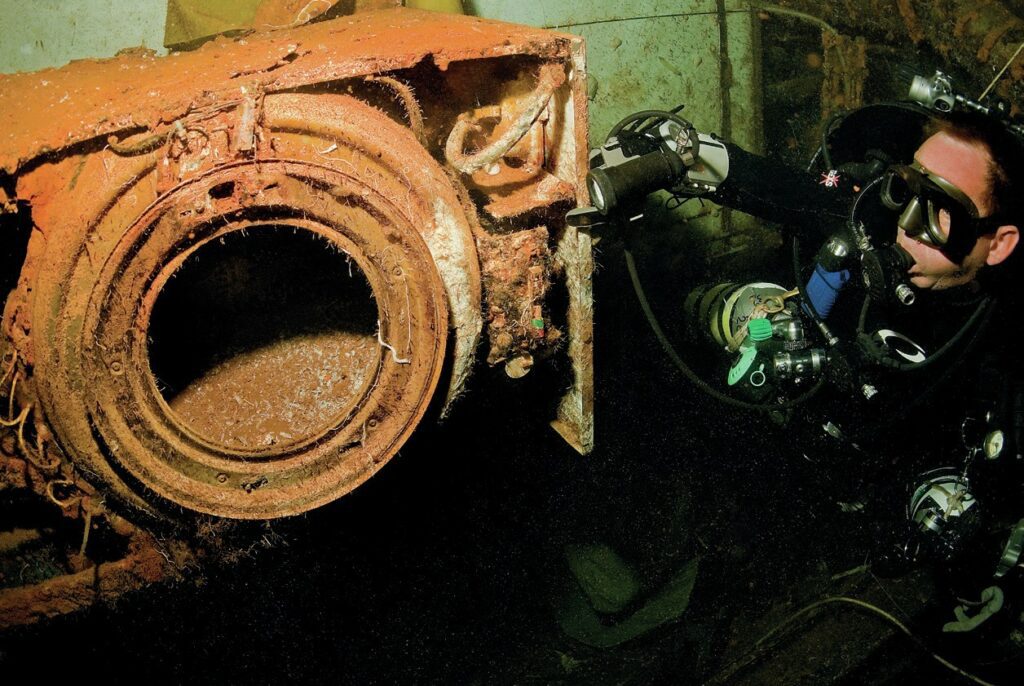
Access to the auxiliary engine room and the control room is usually a special guided dive. In these confined conditions there is no room for safety lines. They would be more of a hazard than an aid, becoming entangled around fins or snagging on gauges. As I followed Chris inside the auxiliary engine room, he shone his torch beam upwards. The steering lube tanks loomed overhead, graduation marks still easily readable. Bright red rusticles hung down like stalactites, a sure sign that the wreck was slowly corroding. The control room lay just ahead, but my flapping fin movements had reduced visibility to near-on zero. It was easy to imagine how divers could become disorientated and lose their way. As a deterrent Chris said ‘we have put a notice on the auxiliary engine room door which says, what’s in this room is not worth dying for’.
Exploring the Outer Zenobia
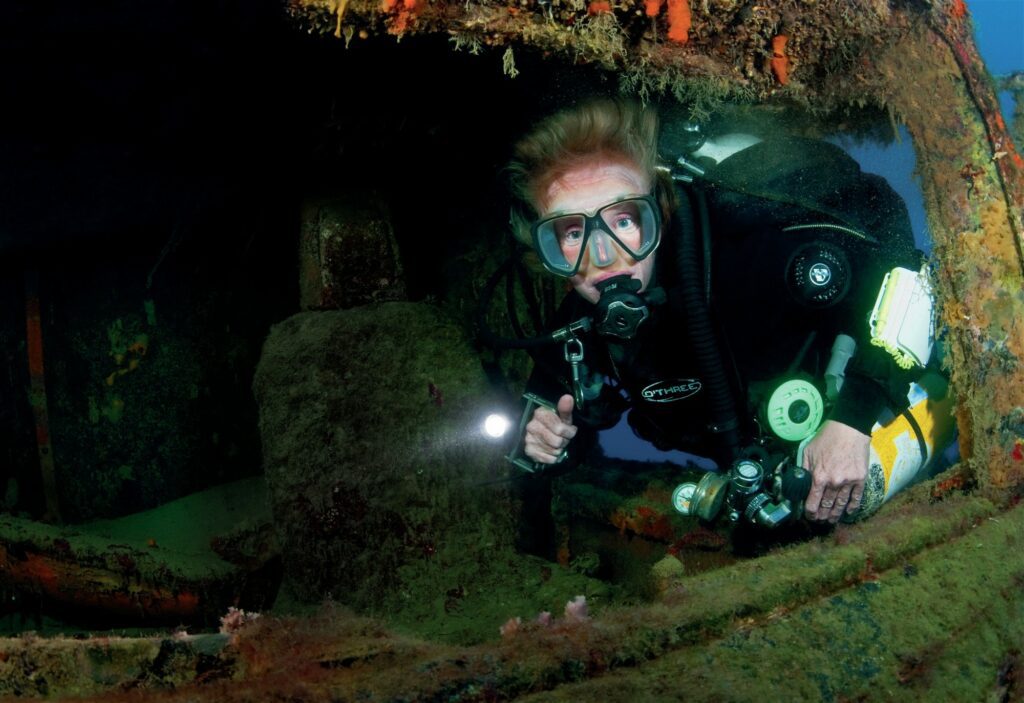
More than 90% of visiting divers are happy to stay outside the Zen where there are plenty of interesting features to keep them occupied. The triple-axle trucks are probably the most popular attraction. It’s possible to see several types of classic flat-nose COE (cab over engine) from Volvo and Scania to DAF, MAN and Leyland. A number of trucks hang precariously from deck chains. I managed to get my guide to pose inside a cab and by the heavy-duty batteries, but I did have a few concerns about the chains snapping and sending us plummeting to the seabed!
Unfortunately, most of the easy accessible cargo has been pilfered. The ‘egg’ truck used to be stacked high with cartons of chicken eggs. These days there are only a few broken shells left on the seabed. The manhole covers and mirror truck still had a few examples. I guess it’s not so easy to put a manhole cover in a BCD pocket! The ‘Bone truck’ is located right at the entrance to the upper car deck. The trailer must have been carrying some kind of meat produce or maybe livestock as there are bones still inside. Some are ‘Fred Flintstone’ size.
Experiencing the Zenobia's Rich Marine Life
The wreck has also become a thriving reef system with plenty of marine species on show from colourful nudibranchs, saddled bream and damselfish to giant grouper and even the occasional hawksbill turtle encounter.
Concluding Thoughts
The MS Zenobia is without doubt one of the top wreck penetration dives in the world. Chris said ‘the best time to dive the Zen is at five o’clock in the afternoon, this is when she looks like a sad wreck’. He continued ‘you don’t own the Zen you just borrow it for a few years. This just happens to be our time’. My time spent deep inside the Zen had been intense. From the initial training all the way through to the lengthy penetration dives. But to explore where very few divers have ventured before was a huge privilege and will never be forgotten.

This article was originally published in Scuba Diver UK #70.
Subscribe digitally and read more great stories like this from anywhere in the world in a mobile-friendly format. Link to the article
